The emergence of new brands continues to shake up the baby diaper category. Although it is still dominated by multinational brands like Procter & Gamble’s Pampers and Kimberly-Clark’s Huggies, the barrier to entry in the baby diaper market has transformed over the last decade, making it easier for new brands to launch and offer what they believe is a unique option for parents.
According to Colin Hanna, director of market research, Price Hanna Consultants, independent diaper brands continue to emerge, benefitting mostly from the affordability of contract manufacturing outside the U.S. “Their biggest impact is not taking marketshare from bigger brands, rather it is on the way all diapers are now being marketed,” he says. “First, all diapers must address the concerns of baby’s sensitive skin. Are they hypoallergenic? Are they free of ingredients that sound toxic? Are they replacing plastic with plant-based ingredients? These key concerns are the result of the way independent brands have successfully appealed to the values to current consumers.”
The independent baby diaper brands that Belgian manufacturer Ontex works with want innovative, efficient and reliable products, according to an Ontex spokesperson. “The cost of the ticket to get into the market is a product that works,” the spokesperson says. “We work together to create a product that stands out in a market where consumers are demanding and looking for a product that fits their lifestyle. Their focus is often on sustainable innovation, but the basics have to be right: protection and skin care.”
Despite the proliferation of new brands that have launched in the baby diaper category, the last few years have been fraught with challenges.
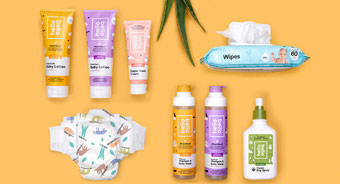
Baby care brand Hello Bello was acquired by private equity firm Hildred Capital Management in December.
Consequently, Hello Bello, founded in 2019 by celebrities Kristen Bell and Dax Shepard, filed for chapter 11 bankruptcy protection in October. The baby and family care consumer products brand, which opened its own diaper manufacturing facility in 2021 after experiencing significant growth, cited high shipping and production costs as reasons for the filing. According to reports, the company’s effort to limit these problems by opening the facility in Waco, TX, a multi-million-dollar investment, did not generate positive results soon enough.
“Given macroeconomic trends, including inflation and increased shipping costs, we believe that this course of action is the best path forward to ensure that Hello Bello continues to bring families the highest quality and most environmentally friendly products at affordable prices,” Erica Buxton, CEO of Hello Bello, said in a statement.
Last month, Hello Bello announced that it was acquired by Hildred Capital Management, a healthcare-focused private equity firm. “We are excited to be part of the Hildred family of companies,” Buxton says. “Hildred has a great deal of experience in this space and with their partnership, we are confident that we will continue to not only make great products but increase our efficiency and manufacturing capacity for our customers and retail partners. We will now be in a stronger financial position and benefit from operational expertise from both Hildred and similarly situated businesses in its portfolio.”
Hello Bello’s mission from inception has been “Premium for All,” ensuring all parents can choose the best options for their babies, no matter their budget. With the acquisition by Hildred, Hello Bello will continue to offer its award-winning premium products at affordable prices and with convenient accessibility, both in top retailers and online, throughout the U.S. Hello Bello remains committed to quality, affordability, sustainability, inclusivity and giving back.
Hildred will transition Hello Bello into its portfolio under the stewardship of Hyland’s Naturals, a Hildred portfolio company, and a leading pediatric consumer health company. With a trusted brand and rich history in the natural marketplace for over 100 years, Hyland’s Naturals offers complementary resources to accelerate Hello Bello’s growth.
In general, Hanna says that one of the major challenges independent brands are facing is affordability. “This is even more important as most family budgets are no longer benefitting from the excess cash that resulted from the pandemic and economic stimulus,” he continues.
Jagadev adds that these challenges have impacted consumers’ brand loyalty. “Now consumers are going for budget-friendly private label brands or larger size purchases,” she explains. “The competitive market has changed after the pandemic. Prices are increasing, and insurgent brands are struggling because they must come up with some sort of differentiating factor to keep up with the market. For them plant-based is not unique. Plant-based and sustainability are the thresholds for any new player to enter this market. It’s the very minimum, if you don’t have this, you are out. It’s suicidal if you come into the marketplace without satisfying the minimum criteria and you’re trying to compete with Pampers and Huggies. Brands have to offer something new, something different for consumers, and at the same time, they can’t also increase their price. If leading brands are offering their products at a certain price, why would consumers go to another product? Now, Pampers and Huggies also have plant-based products and products for sensitive skin. What are insurgent brands offering that will attract consumers to their products?”
According to Euromonitor, insurgent brands or ‘Others’ share has increased in the past two years as these brands are “the flag bearer of innovation,” Jagadev says.
Green Goals
When it comes to innovation, sustainability continues to be one of the major drivers of new developments in the diaper industry. This has come to fruition through the replacement of fossil-fuel based plastic ingredients, while also focusing on end-of-life solutions for diapers, which reportedly take 500 years to decompose in the landfill.Jagadev says sustainability is spearheading consumer preferences. “Transparency in raw materials and manufacturing processes has become essential for brands to retain brand loyalty. This rising sustainability trend is expected to positively impact baby diaper market growth in the coming years.”
At the premium tier, Hanna says they are seeing the replacement of plastic with natural fibers and other compostable ingredients as a differentiator for the most environmentally conscious consumers.
According to Shazi Visram, founder of HealthyBaby, high performance, plant-based materials are the future of the diaper industry. “Parents are becoming even more aware of the negative environmental impact their diapers have, with 73% of first-time parents saying they are trying to decrease the number of disposable products they use for their baby, according to Mintel’s 2023 U.S. Disposable Baby Products report,” she says.
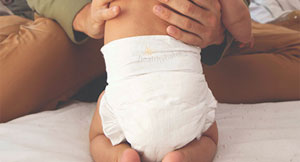
HealthyBaby moved to organic cotton in its backsheet for an even softer sensory experience.
Since the diapers first launched, HealthyBaby moved to organic cotton in its backsheet for an even softer sensory experience. The brand has also replaced post-consumer recycled plastic sleeves with paper sleeves to improve the carbon footprint of its products where every improvement adds up, she adds.
In recent years, developing a compostable diaper has been a focus for some premium brands and diaper manufacturers.
According to Hanna, compostable diapers are a good solution in parts of the world where industrial composting infrastructure exists and is supported by the national government and local municipalities. “We see this in France and Belgium, in particular,” he says.
In France, Mundao has brought an industrially compostable baby diaper to market called Diap’Earth. This diaper, made with bio-based materials such as cellulosic fibers and polylactic acid (PLA), provides a circular solution to the absorbent hygiene product (AHP) waste issue.
So far, Mundao, which works with a contract manufacturer, has achieved a full compostable diaper, which reached more than 91% in a biodegradation test in less than three months. A product is considered industrial compostable when it achieves more than 90% biodegradation in less than six months, and the Diap’Earth diaper composts between four and five months, according to Stéphanie Mazet, co-founder of Mundao, Clients & Marketing.
“Industrially compostable diapers such as ours - Diap’Earth - are expected by people, families and institutions who want to reduce waste (and pollution) generated by baby diapers,” she says. “It is really effective because diapers are a big part of the waste going to landfill (3 million tons of waste in the U.S.), and people want diapers that are really transformed into compost.”
Mazet says they are witnessing a growing demand for compostable diapers and reducing waste. “In France and in Europe there are some regulations now making it almost compulsory to reduce the amount of waste, so we have to find solutions to get the diapers out of landfill or incineration,” she explains. “And now, more and more public structures and families are interested in it because having waste is becoming more expensive.”
At this time Mundao’s Diap’Earth diapers are available to consumers, in partnership with cities, nurseries and families, through pilot programs in France, where the diapers are collected and sent to industrial composting facilities. “We are assembling an entire ecosystem with a lot of partners to achieve this, from materials’ suppliers to collectors, composting facilities and customers,” Mazet says.
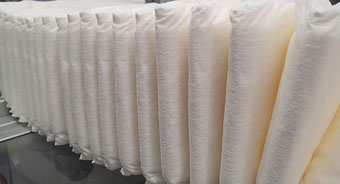
Mundao’s Diap’Earth is a new industrially compostable baby diaper that has debuted in France.
Meanwhile, Belgium-based diaper manufacturer Drylock, in partnership with the brand Love & Green, have developed a compostable diaper.
Combining softness and high-class performance, the new product is essentially biobased and biodegradable at the same time. Both companies have already developed and marketed various hygiene products with distinct ecological features, such as unbleached fluff, biobased liners and paper packaging. The recent two-year research project now culminates in the development of a biodegradable and compostable diaper.
“We are committed to naturality and circularity, so to have a global first compostable diaper was an obvious target for us,” says Jules Van Malderen, business development director at Drylock Technologies. “However, it was not easy—and together with our commercial and scientific partners, we were constantly on the edge of what is currently technologically possible. At this point in time, we do not recommend people to compost soiled diapers at home, for reasons of health and hygiene. However, by launching this diaper, we allow institutes like hospitals and kindergartens, where products are used professionally and can be efficiently collected, to choose an eco-friendly, low impact solution.”
To guarantee a product performance that is comparable to other top grade baby diapers, the product concept is based on Drylock’s proprietary and patented channels technology, as well as on other technologies in the field of nonwovens and bio compositions, for which patents are pending.
Drylock and Love&Green stress the importance of being fully compostable. Van Malderen explains why: “Intellectually, there is no such thing as being partially compostable. Either you’re compostable—or you’re not.”
Aside from being compostable in any standard composting facility, the product content consists of materials that are based on natural, vegetable origins for 80 to 90%—and it is the objective to push this over the 90% limit in the near future. In addition to the diapers, and based on the same principles, a full range of baby products including baby pants will be developed and marketed.
When it comes to diaper disposal, Dyper, a plant-based baby diaper brand, has been diverting millions of pounds of diaper waste from landfills through its landfill avoidance program Redyper, which turns used diapers and wipes into nutrient-rich topsoil for large-scale landscaping, roadside plantation and growing sod.According to Katja Lerner, Dyper’s chief product officer, there is a generational shift taking place with a heightened focus on health and the role the environment plays. “This was only enhanced with the changed landscape after Covid and has led to a growing demand for compostable diapers, largely driven by environmentally conscious consumers,” she explains. “The move towards sustainable and eco-friendly products aligns with both consumer preferences and, in some cases, government initiatives promoting environmental responsibility. However, our ability to scale our landfill avoidance solutions and compostability largely depends on waste management facilities and local municipalities to make this process more mainstream.”
Currently not all parts of the Dyper diaper can be composted, specifically the tabs of the diaper must be removed before the diaper can be composted. “Every day our mission is to look for new ways to improve diapers’ end of life, not only via materials but also through other breakthrough innovations, such as our work in the Biochar space, which fully biochars our diapers turning them into charcoal through the process of pyrolysis,” Lerner says.
Last year, the company became the first diapering company in the world to successfully “char” a diaper with its Byochar technology. With this innovation, Dyper entered the biochar economy by turning soiled diapers into biochar. Biochar is a carbon-rich product created through a heating process called pyrolysis, which allows for waste to be transformed into a reusable commodity that can improve soil, assist in air and water purification and be an additive to paints and inks for improved pigment.
What’s New?
In new product news, Dyper recently introduced Charcoal Enhanced Diapers, featuring a black topsheet infused with 3% charcoal from Bamboo, which is well known for its filtering and odor-fighting properties.“When we realized we could use charcoal to give our diapers a new look, we started questioning everything. Why should all diapers be white? So, we designed something innovative,” Lerner says. “This product line maintains our high level of plant-based diaper content our customers love, with added charcoal giving it a fresh color and sleek aesthetic. The result is a diaper that stands out from the crowd.”
Lerner adds that the product is not gimmicky (like a white diaper now in black). “Charcoal looks very differentiated,” she says. “We listen to our customers, understand the market dynamics in the category, and look into what is trending and resonating with consumers. Charcoal is in toothpaste, facial products and drinks. It has very different properties and is known for its absorbent and deodorizing qualities.”
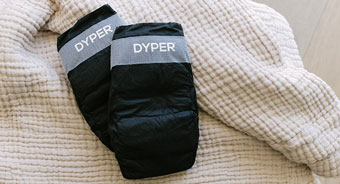
Plant-based baby diaper brand Dyper recently launched charcoal enhanced diapers.
“It’s almost like a radical innovation shocker,” Lerner says. “It’s not for every mom, but there’s a certain group of moms at the forefront of innovation and trying different things that absolutely love the product.”
Dyper Charcoal Enhanced Diapers have undergone rigorous independent testing and are Certified Standard 100 by OEKO-TEX for the absence of harmful substances. They are hypoallergenic and feature a plant-based inner layer to lock away moisture and help keep little ones dry and comfortable. Made with FSC Certified wood pulp and without chlorine, natural rubber latex, alcohol, TBT, parabens, or phthalates, they’re soft, absorbent, and safe—no dyes, prints, or fragrances.
Outside of the plant-based trend, major diaper manufacturers have launched other new developments in baby diaper technology in recent months.
In October, P&G launched an innovation for its Pampers Swaddlers line that aims to tackle diaper blowouts—the Blowout Barrier. The new Blowout Barrier helps prevent up to 100% of leaks, even blowouts—giving parents one less thing to fear, according to the company.
With a unique back waist cuff, front waistband and absorbent topsheet designed to help prevent diaper leaks, Pampers Swaddlers are made to keep baby’s skin dry and healthy.
“This is an exciting new innovation for Pampers,” says Marty Vanderstelt, senior vice president—North America Baby Care. “I still remember an epic diaper blowout I experienced with my son while we were at the park without a bathroom or changing room in sight. We created the new Blowout Barrier to give parents peace of mind and help do away with what was always considered a parenting rite of passage.”
Last year, P&G also launched Pampers Swaddlers in size 8 for babies 46 pounds and up, available at Walmart and Walmart.com.
“As a pediatrician, I recognize many parents may reach a stage where their child isn’t ready to begin potty training, remain in diapers and potentially require a larger diaper size to fit their family’s needs,” says Dr. Amna Husain, Board Certified Pediatrician, Board Certified lactation consultant and mother of two. “I, myself, have experienced needing different diaper sizes for my girls at different ages and the chance to have more options like Pampers Swaddlers size 8 is incredibly helpful.”
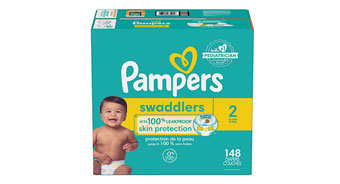
Pampers Swaddlers’ new Blowout Barrier is designed to help prevent up to 100% of leaks.
“At Pampers we know that no little one’s diapering journey is the same, which is why we pride ourselves on ensuring our products are inclusive for all babies,” says Vanderstelt. “We’re proud to be the first major national diaper brand to offer this option to parents.”
Some of Ontex Group’s latest innovations have focused on the fast-growing baby pants business. Its new technologies, Ontex Dreamshield and X-Core, meet consumer demand for ease of use, discretion and leakage protection.
While baby pants have traditionally been designed to assist parents in the early stages of potty training, making it easier for children to transition from diapers to regular underwear, they are becoming a popular alternative to open diapers, especially in Europe. According to Nielsen data for the 12-month period ending in April 2023, baby pants are the only volume-growing segment in Europe, with a notable growth rate of 13%, which is largely driven by retail brands. According to Euromonitor, baby pants are expected to continue to drive the category growth over the next five years. The growing acceptance of pants among parents is a key factor behind this trend.
Ontex’s Dreamshield back pocket in baby pants offers upgraded leakage protection, which is a key driver for parents to shift more to pants to more extended usage including at night. Additionally, Ontex’s channeled X-Core technology has allowed the company to make an innovative core that improves performance and meets the top three needs of consumers in this category: protection, comfort and discretion.
Meanwhile, Japanese diaper manufacturer Unicharm’s Vietnamese subsidiary Diana Unicharm launched a one-side open pants style diaper under its Bobby baby care brand in Vietnam. The product, which was introduced in October, is thought to be the world’s first diaper design that combines a traditional open-tape style on one side and a pull-on design on the other.
According to the company, parents in Vietnam prefer baby diapers that do not tightly constrict the waist and like to avoid lifting the baby’s legs during diaper changes, as it may risk dislocating the hip joint. Therefore, they are very cautious when selecting diaper pants.
Bobby One Side Open Pants features a one-sided opening design in the waist area which can provide a gentle and snug fit around the baby’s tummy and allow diaper changes without lifting their legs, even when the baby is asleep.


